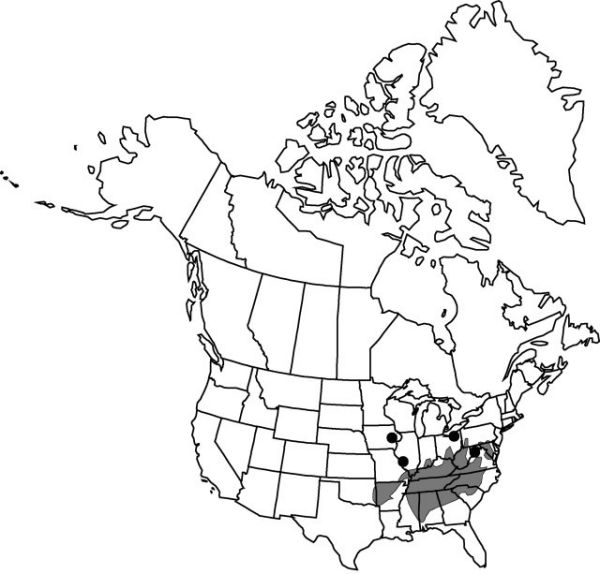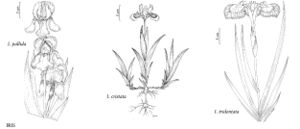Iris cristata
Hort. Kew. 1: 70. 1789.
Rhizomes producing fleshy roots, and 2–8 cordlike branches at apex, cordlike portion 2–3 dm × 1–2 mm, gradually enlarging to 8–12 mm diam., nodes with brown, scalelike leaves and rarely roots. Stems simple, 2.5–4.5 cm. Leaves: basal 6–8, proximal 2–3 sheathing, blade light brown with darker brown line along midrib at base, falcate, scarious, distal 4–5 not sheathing, blade green or yellowish green, with few, subprominent veins, broadly ensiform, slightly falcate, to 1.5 dm × 1–2.5 cm, enlarging to 4 dm after anthesis; cauline 2–3, sheathing, proximal very similar to basal leaves, distal 1 or 2 reduced, herbaceous, blade falcate, not inflated. Inflorescence units 1–2-flowered; spathes green, sharply keeled, somewhat inflated, 2–6 cm, unequal, outer shorter than inner. Flowers: perianth blue, lilac-purple, or white; floral tube filiform, widening distally, 4–8 cm, lifting expanded portion of flower out of spathes; sepals spreading, with 3 parallel, toothed, crested ridges on white signal bordered with purple, tapering gradually into claw, 3–6 × 1.5–2.5 cm, base gradually attenuate, apex rounded, emarginate; petals spreading, same color as sepals, oblanceolate, 3–4 × 1–2 cm; ovary triangular, with shallow groove along each face, 0.6–1 cm; style 1.5 cm, crests narrowly triangular, 6–9 mm; stigmas oblong, margins entire; pedicel 0.7–1.8 cm. Capsules usually enclosed in spathes, oval, sharply triangular, each angle ridged, 1–1.5 cm. Seeds yellowish brown, 3.2–3.5 mm, smooth, with narrow, white appendage wrapped around seed, 3.4–4 mm, quickly drying upon exposure to air. 2n = 24, 32.
Phenology: Flowering Apr–Jul.
Habitat: Rich woods, ravines, bluffs, usually in calcareous soil
Distribution

Ala., Ark., D.C., Ga., Ill., Ind., Iowa, Ky., Md., Miss., Mo., N.C., Ohio, Okla., Pa., S.C., Tenn., Va., W.Va.
Discussion
Selected References
None.
